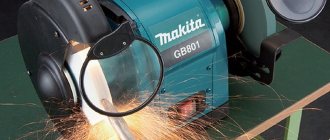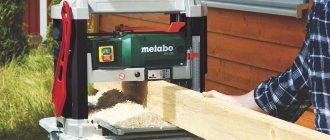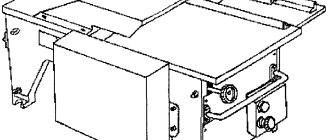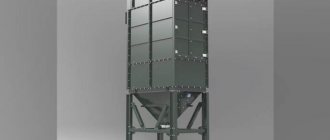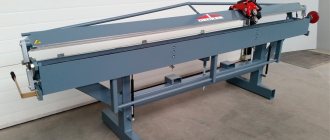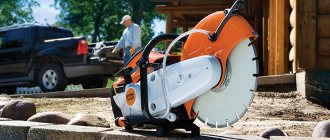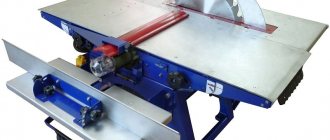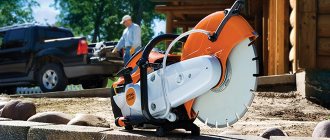Wood products have long become a familiar part of our environment, and we rarely think about how exciting the process of creating such ordinary things can be. Professionals, and even amateur carpenters, know exactly how to handle wood, but without a tool such as a woodworking machine, all this knowledge becomes meaningless.
What is a woodworking machine?
Wood processing involves a number of different manipulations, each of which can be performed with a separate tool. However, cluttering the space with them and transferring the product from one device to another will cause a lot of inconvenience. That’s why the multifunctional woodworking machine, an electric mechanism that allows for comprehensive and complex processing of any type of wood, has gained popularity among craftsmen.
Woodworking machine structure
All spare parts that make up a standard wood processing machine are divided into main and auxiliary. The task of the former is to ensure successful manipulation of the material and supply of raw materials. They are powered by a gasoline or electric engine. The rest cover secondary needs - protection in dangerous areas, lubrication, adjustments. All elements are located on one base - the so-called bed.
Depending on the type, a universal woodworking machine may have a different design, which includes:
- Cutting mechanisms: rollers on movable or static fastenings with grooves for cutting tools - cutters, drills, circular saws.
- Material feeding devices: table, clamps, guide rulers.
- Protective elements: the woodworking machine reliably protects the craftsman from possible injuries with various covers, caps, shields, and fences.
- Control mechanisms: all kinds of levers, buttons, pedals, even a computer.
Types of machines by operations performed
One of the divisions of machines occurs according to the types of technological operations and methods of material processing:
- Turning. The operation involves the processing of cylindrical workpieces and is performed on center, circular or lobe lathes.
- Sawing Includes cutting and trimming using the method of transverse, longitudinal and curved cutting of the material. These tasks are handled by: format-cutting, cross-cutting and jigsaw installations, band saws, circular saws and circular saws.
- Planing. The workpieces are processed along the profile and along the plane, providing a flat surface of the part (board, board). You can use planing, jointing and thicknessing machines.
- Drilling. The operation of making through holes or preparing nests using drilling, slotting and drilling-grooving equipment.
- Milling. It consists of cutting off the surface layers of material from the workpiece in specified places. It is used for profiling parts, and is widely used to give a decorative appearance to products. It is achieved using milling, longitudinal-milling, copy-milling and four-sided machines.
- Pressing. It is used for the production of plywood and chipboard, fibreboard, OSB, MDF boards based on fine wood waste. Materials acquire a smooth and solid structure under the influence of a press.
- Grinding. Removes defects in the form of burrs, sharp corners, small waves. It is used both to smooth the surface and to give it roughness. To perform the operations, disc, drum, combined or oscillating grinding machines are used.
Wood processing
Pros and cons of a multifunctional woodworking machine
When deciding whether to purchase a universal woodworking machine, you should weigh and evaluate all its advantages and disadvantages. The tool has a number of undeniable advantages, because it:
- Multifunctional
. It alone replaces a sawmill, a router, a grinder, a lathe and a number of other devices. - Takes up little space
. All of the wood processing equipment listed above requires a lot of space, which cannot be said about a single, but multifunctional device. - Economical
. Buying one device instead of several will obviously be more wallet-friendly. - Adaptable
. A woodworking combined machine is not produced according to one pattern - you can choose a model with the desired set of functions.
Although, if your plans only include sanding wood, for example, then the need to overpay for other functions that will not be used will rather be a disadvantage of a universal machine. In addition, its power is not enough for particularly precise work - other specialized devices are required. Although it ideally covers household and non-production needs, more complex tasks need to be solved using other devices, and this is a significant disadvantage.
What to look for when purchasing
When going for woodworking equipment, you should pay attention to the following details in order to purchase a durable and reliable working unit:
- Are there additional accessories included in the kit for a wide range of carpentry work? A correctly selected machine configuration will allow you to perform up to 11 different operations, such as sawing, planing, milling, thicknessing, drilling and tenoning.
- It is better to give preference to the universal option.
- The weight, size and nutrition of the product are of no small importance. The device for the home must operate from a 220 volt network.
- Technological capabilities will also be an important feature of the future acquisition.
Advantages of some models of woodworking equipment
The convenience of combined options for the home lies in the combination of several functions to work in one device. For example, the Corvette-320 is capable of performing drilling, milling and planing operations.
In addition to being versatile for a wide range of woodworking profile tasks, it is capable of performing planing, ripping and cross-cutting work. The device allows you to drill holes and some milling operations.
For more accurate work, you can connect it to a vacuum cleaner. Thanks to its small size, it can easily be placed in small spaces, such as a home or garage. The device has a low noise level thanks to an asynchronous motor and belt drive.
Among the advantages of this device are the following:
- Equipped with an asynchronous motor.
- Reducing noise during operation and protecting the engine from overload thanks to a belt drive.
- Planing table made of cast iron.
- A guide bar is provided for planing and sawing operations.
- Equipping the planing shaft with a protective strip.
- The design includes a pipe for connecting a vacuum cleaner.
- The table is equipped with a movable table with a transport stop for sawing operations.
- The saw blade is equipped with a protective cover for safe operation.
- The reach of the saw blade can be adjusted in height.
- To perform milling operations using end mills and drilling, a workpiece is placed on a cast iron table and pressed with a powerful clamp.
Such a machine can be purchased for about forty thousand rubles.
Another combined machine, Master-200, for wood processing has found wide application in small carpentry workshops and households. Thanks to modern technical equipment, it allows processing parts from different types of wood. The advantage of this machine is that all cutting tools are equipped with special barriers to ensure safe work for the master. To maintain accuracy and reduce vibration during operation, the tables are made of cast iron and equipped with a rigid frame.
Types of woodworking machines
As already mentioned, wood processing equipment can perform one function or combine several. According to this principle, they are divided into three types:
- universal
– have a whole range of functionality; - specialized
- designed for one type of work; - special
- created for processing a specific type of part.
A universal wood cutting machine can be used for home use, semi-professional or professional use. The devices also differ in power and the type of built-in engine - electric or gasoline. Specialized machines are divided into types, depending on their functions:
- Planing of wood is carried out on planing, jointing, thicknessing devices.
- A band saw or circular saw or jigsaw can handle the cutting.
- You can drill holes using a vertical or radial drilling machine.
- Milling, grinding and sharpening are performed on milling, grinding and turning machines, which is logical.
Thicknesser and planer-thicknesser machines
The cut lumber must be processed: remove the top layer with notches, burrs, knots, and deformations. And also give the workpiece the required size and configuration. Specialized machines for these purposes are surface thicknessers, also known as planers. A universal or planer-thicknesser will also cope with the task.
The working surface of the surface planer is divided into two parts: feeding and receiving. Submission of material for processing can be manual or automatic. Before starting work, the thickness of the future part is set in the workshop.
A surface planer can have a different number of knives; the more, the better the processing. Knives are placed on top, bottom or both sides.
The thicknesser works with boards that have already been planed, so they are first planed using separate equipment, or a planer-thicknesser machine is purchased to work with unplaned boards. First, you remove the top, rough layer of wood with your own hands, after which a thicknesser brings the workpiece to condition.
Main technical characteristics:
- number and location of knives;
- engine power;
- workpiece feed speed;
- size of the processed blank;
- dimensions and weight.
Which woodworking machine should you choose for your home?
For household needs, a small universal woodworking machine for the home is optimal. When choosing a suitable model, pay attention to:
- Method of manufacturing the frame: welded is quite suitable for home use. A cast element is needed for working with large products in an industrial environment and seriously affects the cost of the machine.
- Power: the optimal indicator for a household appliance motor is up to 2.2 kW, and everything higher is intended for professionals.
- The manufacturer’s reputation and reviews of a specific model: both famous brands and little-known companies can create both successful and not very successful machine configurations. Collect as much information as possible about the device you are interested in.
Rating of woodworking machines
The most popular universal machines today:
- Woodworking machine SDMR-2000, Belmash
. An excellent example of Belarusian production, equal in quality to Japanese and German devices. Lots of functions, ease of changing modes, good fit, all this is quite reasonable money. - Combined woodworking machine JET JKM-300
. A compact device for the home workshop with the potential of professional equipment and Swiss quality. - Multifunctional machine STARK CWM 3050
. This small German device, with a colossal power of 3 kW for a home device, will replace an entire woodworking workshop.
Advantages and disadvantages of combined equipment
Standard arrangement of machine components
First of all, you should consider the feasibility of purchasing a combined woodworking machine. If in a home workshop it is necessary to perform a full cycle of processing workpieces, from cutting to jointing, such equipment is simply necessary. In all other cases, it is best to limit yourself to highly specialized machines.
First you need to analyze the positive and negative aspects of operating equipment of this type. In this way, you can determine the main qualities that a combined woodworking unit should have.
Based on the analysis of technical and operational characteristics, the following positive aspects of the equipment can be identified:
- relatively small size;
- the ability to perform basic woodworking operations on one equipment;
- affordable price. It is due to its simple design and the absence of electronic control components;
- choice of tabletop and floor-standing models. Home craftsmen prefer the first option. The machine is mounted on a frame, the height of which is adjustable by the user.
But in addition to the positive qualities, it is necessary to take into account a number of possible disadvantages:
- low performance indicator;
- restrictions on the size of the wooden workpiece - thickness, length and width.
However, despite the negative qualities of the equipment, its positive aspects prevail. This is why combined machines for processing wooden blanks have become so popular and are widely used not only at home, but also to equip small production workshops.
In many ways, the characteristics of the machine depend on the quality of the materials used. Models with work tables made of cast iron alloy have the best performance indicators. This not only gives stability to the structure, but also preserves the original geometry of the working surface for a long time.
How to operate a woodworking machine?
It is important to remember that woodworking equipment is dangerous, so when working with it, be sure to follow the safety rules:
- Do not allow intoxicated persons to access the device.
- Choose clothes that do not restrict movement, without loose elements that could get caught in the mechanism.
- Do not operate the machine if any of its parts are broken.
- Make sure that the woodworking machine is well lit and not dirty when working.
- Use safety glasses.
Safety rules when working on the machine
It doesn’t matter what kind of machine the work is carried out on: professional or household. The requirements for carrying out work on them are the same:
- Drunk or sick people should not be allowed to access the machine;
- persons with physical disabilities are also prohibited from working there;
- clothing should be tight-fitting without developing ends that could get caught in rotating parts;
Overalls for working at the machine
- the workplace should be well lit and clean;
- It is prohibited to work on a faulty machine;
- All required protective devices must be used: screens, covers, etc.;
- If there are no protective screens in the design, then you must wear glasses.
You must wear safety glasses when working
Bending machines
An unusual type of woodworking machine that does not involve removing layers of material. The purpose of bending machines is to give wooden elements a special shape that is unattainable by other methods. Structurally, they are hydraulic presses equipped with specialized clamps and
forming heads, and also, optionally, means for preparing the material for molding.
Bending wooden blanks on bending machines allows you to create complex, elegant parts, which is widely used in the production of exclusive furniture.
How to choose a wood lathe
Among the variety of types of wood lathes, it is quite difficult to make the right choice. The future owner must decide on the list of tasks (the set of operations performed) that the unit must perform. In order not to purchase an unnecessary unit, you should decide on the following requirements:
- what tasks are planned to be solved using the selected machine;
- how often it is planned to be used;
- where it will be installed;
- What are the possibilities for energy supply?
The offered models of lathes are capable of meeting the most stringent requirements of the future owner.
When considering the first requirement, you should understand why the selected unit is needed. If you plan to carry out a large number of processing operations, including large-sized wooden parts, you should opt for devices of the industrial or semi-industrial group.
It should be remembered that work on such equipment will require a sufficiently large area to accommodate it and a powerful electrical network, since they are all equipped with energy-intensive motors. The brand of the selected unit is of great importance. It can serve as a guarantee of quality and reliability.
When processing wood products in a home workshop, the choice is desktop machines. Such machines are easily installed in a garage, small workshop, or country house. They will perform almost the same functions, but take up less space, have relatively little weight and do not consume a large amount of electricity. Machines of this type are used for processing and manufacturing small-sized wood parts in limited quantities. A home machine has another significant advantage - reasonable price. However, many turning units from this group have broad functionality for working with wood and are often not inferior to semi-professional units. For them, a device can be purchased or developed to increase its productivity and the quality of the processed surface. In this case, they are capable of processing cylindrical, cone-shaped or shaped surfaces.

